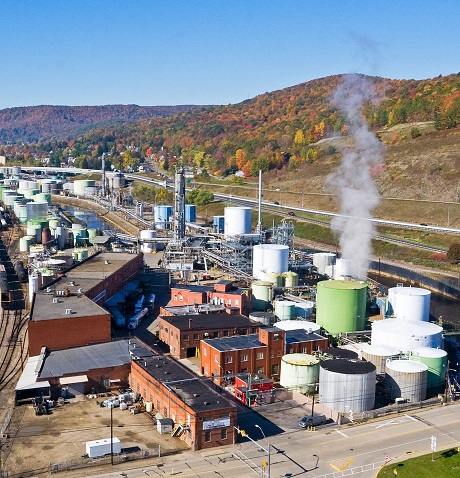Pico Canyon oilfield brought pipelines, refineries, and Chevron.
Following the 1859 first commercial U.S. oil discovery in Pennsylvania, the earliest petroleum exploration companies were attracted to California’s natural oil seeps. Small but promising discoveries after the Civil War led to the state’s first gusher in 1876 — and the launching of a new California industry.
Pico Canyon, less than 35 miles north of Los Angeles, produced limited amounts of oil as early as 1855, but there was no market for the petroleum found near natural oil seeps. The first California drilling boom arrived a decade later in the northern part of the state with an oilfield also found near seeps.
Humboldt County Oil
Completed in 1865 by the Old Union Matolle Oil Company, the Humboldt County well produced oil near the aptly named Petrolia. The oilfield discovery quickly attracted some of America’s earliest exploration companies.
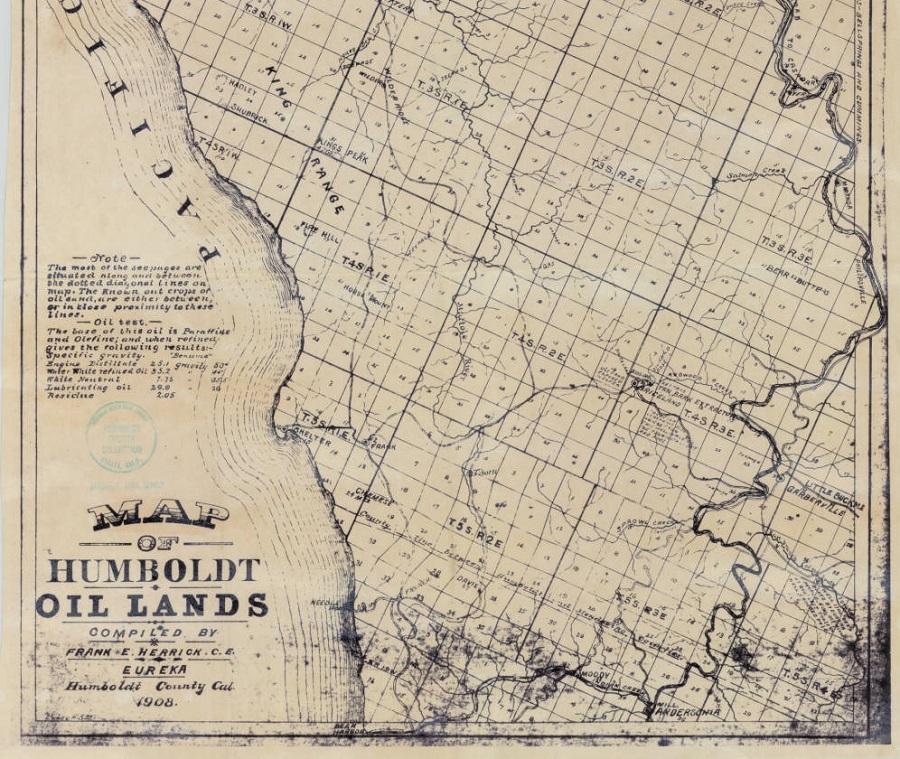
Detail of a 1908 “Map of Humboldt County Oil Lands” includes post-Civil War commercial oil wells that attracted more drilling to northern California. Map courtesy Humboldt County Map Collection, Cal Poly Humboldt Library Special Collection.
A California historical marker (no. 543) dedicated on November 10, 1955, declared:
California’s First Drilled Oil Wells — California’s first drilled oil wells producing crude to be refined and sold commercially were located on the north fork of the river approximately three miles east of here. The Old Union Mattole Oil Company made its first shipment of oil from here in June 1865 to a San Francisco refinery. Many old wellheads remain today.
Although the “Old Union well” initially yielded about 30 barrels of high-quality oil, production declined to one barrel of oil per day, and the prospect was abandoned, according to K.R. Aalto, a geologist at Humboldt State University.
The Humboldt County well in what became the oilfield “attracted interest and investment among oilmen because of the abundance of oil and gas seeps throughout that region,” Aalto noted in his 2011 article in Oil-Industry History. But the California petroleum industry truly began to the south, at Pico Canyon Oilfield, a few miles west of Newhall.
Pico Canyon Well No. 4
In Pico Canyon of the Santa Susana Mountains, Charles A. Mentry (1847-1900), who had formed a partnership establishing the California Star Oil Works Company, drilled three exploratory wells between 1875 and 1876. All showed promise, and the first West Coast oil gusher arrived with his fourth well. The oilfield discovery would lead to the creation of a major oil company.
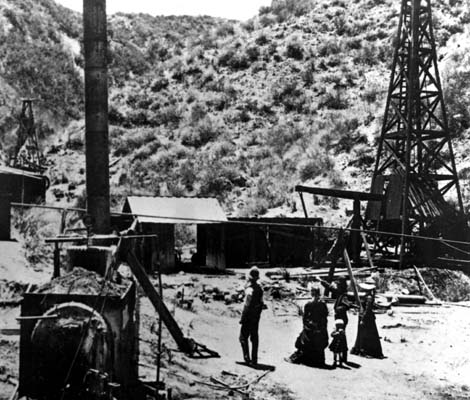
The steam boiler and cable tools, including the “walking beam,” of Pico Well No. 4 in 1877. Photo by Carleton Watkins courtesy Los Angeles Public Library Photo Collection.
Drilling with a steam-powered cable-tool rig in an area known for its many oil seeps, Mentry discovered the Pico Canyon oilfield north of Los Angeles. California’s first truly commercial oil well, the Pico Well No. 4 gusher of September 26, 1876, prompted more development, including pipeline construction and an oil refinery for producing kerosene.
According to an article in the Los Angeles Times, the well initially produced 25 barrels a day from 370 feet. Mentry improvised many of his cable tools, including making a drill stem out of old railroad car axles he welded together.
“The railroad had not then been completed, there was no road into the canyon, water was almost unattainable, and there were no adequate tools or machinery to be had,” noted the Times article.

Charles Mentry had already successfully drilled 42 wells near Titusville, Pennsylvania, before exploring in the Santa Clara Valley — and launching California’s petroleum industry. Photo courtesy KHTS Radio, Santa Clara.
Mentry persevered, and his success in Pico Canyon led to the founding of “Mentryville,” the onetime drilling boom town that is today the site of Stevenson Ranch.
“Although his life was tragically cut short by illness on October 4, 1900, from typhoid fever, Mentry’s legacy as a pioneer in California’s oil industry endures,” noted KHTS Radio, Santa Clara. “His work in Pico Canyon not only made him a key figure in the region’s development but also set the stage for California’s future as an oil-rich state,” KHTS reported in 2025.
Visit the Santa Clarita Valley Historical Society website to learn more Pico Canyon petroleum exploration and production history.
First Refinery
California Star Oil Works deepened the well to 560 feet, increasing daily production by 125 barrels, and constructed its pipeline from Pico Canyon to the newly built refinery in Newhall, just south of Santa Clarita.
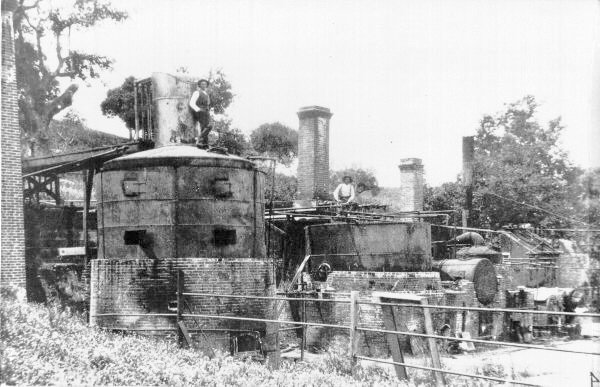
By 1880, California’s first commercial refinery processed oil from its first commercial oil well to make kerosene and other products. Photo courtesy the Santa Clarita Valley Historical Society.
Producing kerosene and lubricants, Newhall’s Pioneer Refinery on Pine Street would become the first successful commercial refinery in the West. Giant stills set on brick foundations included two capable of producing 150 barrels a day each. The city of Santa Clarita received California’s first successful refinery as a gift from Chevron in 1997.
The Santa Clarita refinery, today preserved as a tourist attraction, is among the oldest in the world. The major oil company can trace its beginnings to the 1876 Pico Canyon oil well, which has been designated a historic site by the California Office of Historic Preservation.
Chevron Corporation, once the Standard Oil Company of California, in 1900 acquired Pacific Coast Oil Company. Pacific Coast had become majority owner of California Star Oil Works in 1879.
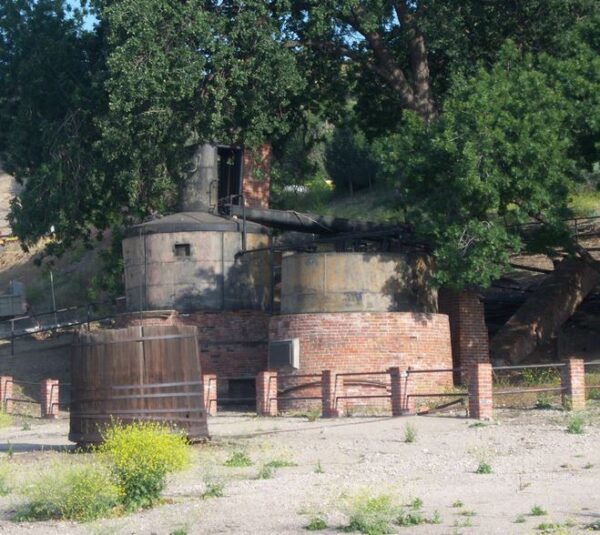
Santa Clarita acquired California’s first refinery as a gift from Chevron in 1997. It is one of the oldest existing oil refinery sites in the world. Photo by Konrad Summers.
Refining Kerosene for Lamps
California’s commercial refineries were among the first in America, where the industry began with small refineries in Pittsburgh, Pennsylvania, producing kerosene for lamps. The oil came from Titusville area oilfields — and a giant 1871 field discovered at Bradford, about 70 miles to the northeast.
The Bradford oilfield, which became known as America’s “first billion-dollar oilfield,” launched many Pennsylvania refineries, including the still-operating American Refining Group. The field’s first well produced just 10 barrels a day from 1,110 feet.
By 1875. Bradford leases reached as high as $1,000 per acre. A decade later, a sudden decline in the oilfield’s production led to a technological breakthrough. Pioneers in the new science of petroleum geology suggested that water pressure on oil sands could be used to increase oil production — “waterflooding” the geologic formation.
In Neodesha, Kansas, the Norman No. 1 well of 1892 revealed a petroleum-rich geologic region that would extend across Oklahoma, Texas, and Louisiana. Standard Oil built a refinery in Neodesha in 1897 that refined 500 barrels of oil a day. Standard was the first to process oil from the giant Mid-Continent field (learn more in Kansas Well reveals Mid-Continent).
In 2024, there were 134 operable petroleum refineries in the United States, according to the Energy Information Administration (EIA). The newest refinery with significant downstream capacity — a facility in Garyville, Louisiana — came online in 1977.
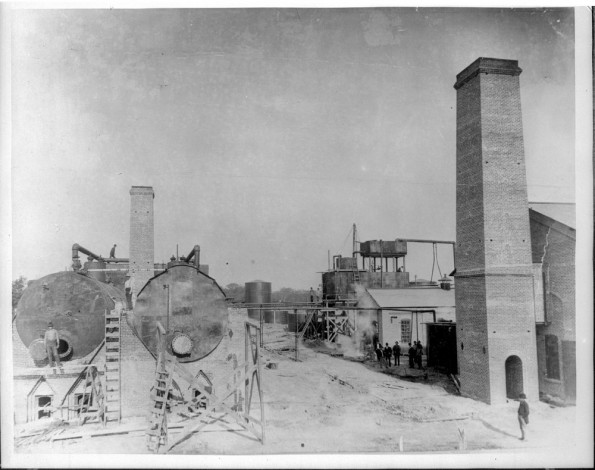
Built in 1897, a Standard Oil refinery in Neodesha, Kansas, refined 500 barrels of oil per day – the first to process oil from the Mid-Continent field. From “Kansas Memory” collection of the Kansas Historical Society.
For an investigation into which California oil well was the first, see this 2011 SearchReSearch blog of Dan Russell.
Learn more California petroleum history in the Signal Hill Oil Boom.
_______________________
Recommended Reading: California State University, Dominguez Hills (2010); Pico Canyon Chronicles: The Story of California’s Pioneer Oil Field
(1985). Your Amazon purchase benefits the American Oil & Gas Historical Society. As an Amazon Associate, AOGHS earns a commission from qualifying purchases.
_______________________
_______________________
The American Oil & Gas Historical Society (AOGHS) preserves U.S. petroleum history. Please become an AOGHS annual supporter and help maintain this energy education website and expand historical research. For more information, contact bawells@aoghs.org. Copyright © 2025 Bruce A. Wells.
Citation Information: Article Title: “First California Oil Well.” Authors: B.A. Wells and K.L. Wells. Website Name: American Oil & Gas Historical Society. URL: https://aoghs.org/petroleum-pioneers/first-california-oil-well. Last Updated: September 17, 2025. Original Published Date: September 9, 2015.



